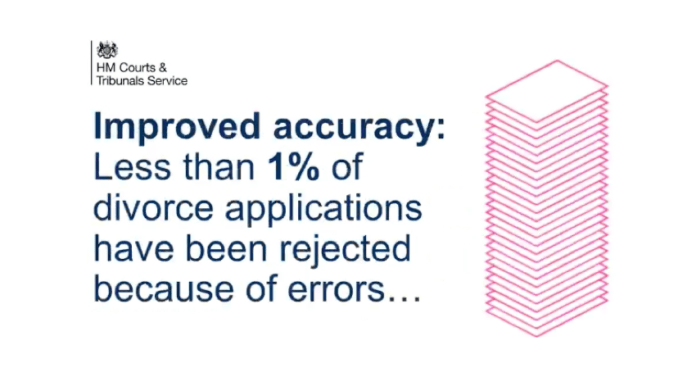
After a long period of development and testing the UK’s HM Courts & Tribunals Service has rolled out an online divorce application platform.
Moreover, although this is not using some of the more powerful legal technology, such as machine learning and NLP, once a process is made digital those in charge can begin to collect data to improve the service, and perhaps in the future look to see how certain aspects can be automated.
That is to say, although making an online application is not that Earth-shattering, it is the essential foundation upon which future technological change and efficiency improvement in the courts will be based.
The Courts Service has noted that more than 1,000 petitions were issued through the new system during the testing phase, and with 91% of people saying they were satisfied with the service.
Divorce is just one area of the law and it absorbs a huge amount of time among court staff, time which is paid for by us, the taxpayers. Moreover, this is a court staff that is under extreme financial pressure. And if money gets sucked into paperwork then it cannot go into areas such as Legal Aid. I.e. weak processes in one part of the justice system then impact other areas where access to justice is vital.
Or, as the Courts Service says: ‘Court staff currently spend 13,000 hours dealing with complex paper divorce forms, but this simpler and less technical online service has already contributed to a 95% drop in the number of applications being returned because of mistakes, when compared with paper forms. This means only 0.6% of forms have been rejected since January.’
Justice Minister Lucy Frazer, added: ‘Allowing divorce applications to be made online will help make sure we are best supporting people going through an often difficult and painful time. More people will have the option of moving from paper-based processes to online systems which will cut waste, speed up services which can be safely expedited, and otherwise better fit with modern day life.’
These changes are part of a £1bn ($1.36bn) programme to transform the UK court system with the goal of making it quicker, more accessible and easier to use for all. Other examples of the Government’s court reforms include:
- A digital system which makes it quicker and easier for people to claim money owed, resolve disputes out of court and access mediation.
- A new service which allows people to submit their tax appeals online – drastically cutting the number of applications being returned as incomplete or inaccurate.
- A paperless system, in operation at Lavender Hill Magistrates’ Court, which means thousands of offenders caught dodging fares or using fraudulent tickets can now be punished more swiftly and effectively.
Meanwhile, Adam Lennon, Divorce Service Manager at HMCTS, said in a Courts Service blog yesterday:’ ‘This is only the beginning. We are also currently working with legal professionals to develop an online application for them to use which will allow them to submit a petition on behalf of a client online. We hope to start testing this with a small group of professional users in Summer 2018.’
‘Secondly, we will be applying the same approach that we have taken to designing the divorce service to all family services over the coming years: work is underway to develop a family public law service for proceedings relating to the care of vulnerable children, and work has also started on the private law service, relating to parental disputes over children. We will reuse what we have already learned, as well as some of the technology, to deliver benefits to our users more quickly and at a reduced cost to the tax payer.’